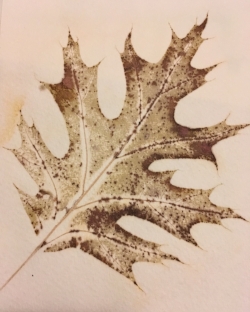Printing on Paper - update
I first posted this article about printing paper in 2015 and have improved upon my process since then!
I use watercolor and printmaking papers available in art stores. Most are a cold-pressed mid-weight paper. Some of my favorites are:
Copperplate paper (used for printmaking)
Rives BFK (also a printmaking paper, gives slightly chalky images)
Canson Student Foundation Watercolor (the cheap kind)
Canson Editions
American Masters Watercolor
Saunders Waterford Rough
Arches Text Wove
and whatever else is on sale or strikes my fancy. More expensive papers do not make better prints, as far as I can tell.
I typically print on pieces that are 1/16th of a sheet of 22 x 30 paper. Approximately 5 x 7".
Step 1: tear or cut the papers to size
Step 2: mordant the paper - papers are made from vegetable fibers, usually cotton and sometimes unspecified cellulose which can be treated the same way. A mordant creates a permanent bond between the natural color and the fibers to increase the light-fastness and range of colors. I use alum (an aluminum salt used in pickling) in the form of alum acetate, a little iron (rusty nails in 1 part vinegar - 1 part water) and a little copper (corroded copper pipes in the previous type of vinegar solution or a tiny dash of Miracle Grow - which contains LOTS of copper) The solution should be colorless or slightly orangey-brown. I use left-over fabric mordant at 15-20% alum acetate, less than 2% iron and less than 1% copper by weight of fabric. The weight ratio is not critical for paper, just a guide for making a solution. I used to soak the papers in buckets for 4 to 24 hours. However, I have learned that simply submerging the paper briefly is just as effective. This is because the fibers in paper are broken down into tiny bits. The mordant solution is able to penetrate the fibers quickly. I enter the papers to the solution one at a time to make sure they are fully exposed and allow them to sit in a pile covered in plastic for half an hour before printing or drying for later use. (Paper may be dried after mordanting and re-wet with tap water before printing.)
Step 3: Lay out plant material on damp, but not dripping paper. Paper, plants, paper. Paper, plants, paper. This reduces some of the secondary prints running through and I never have to decide which of two printed sides I prefer. If I want exceptionally clear prints with no 'background noise' I put a piece of baking parchment paper between the 'sandwiches.' (Paper, plants, paper, parchment, paper, plants, paper, parchment.)
Step 4: I have experimented with a number of methods of steaming, but my current favorite is clamping the pile of papers and plants between two porcelain tiles ($0.99 at Home Depot) and securing them with 2" spring clamps ($1.88 ea). C-clamps work as well, just tighten slowly and each corner evenly or the tile will break. I am not trying to crush the leaves, just to have an even contact between the leaves and the papers.
Step 5: Steam the whole press. I use a large turkey roasting pan with a canning jar lifter in the bottom. I place the clamped tiles on the jar lifter above boiling water, replace the cover and steam for approximately 1 hour. I un-layer the papers as soon as I can touch the tiles and clamps. Some practitioners let their pieces sit overnight, but I've found that I get brighter colors if I open them sooner rather that later. Sometimes the leaves stick to the paper; just wait until the paper dries and they will peel or scrape off without smearing. Allow the papers to dry flat.
Remember, you're only committed to several sheets of watercolor paper, experiment, play!

